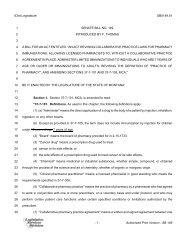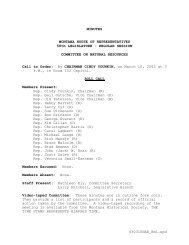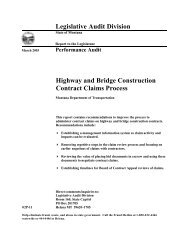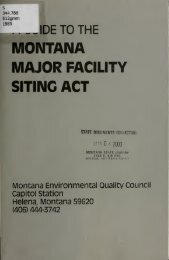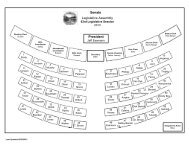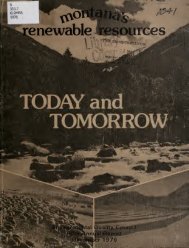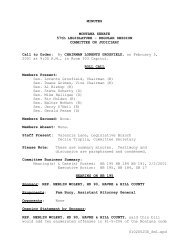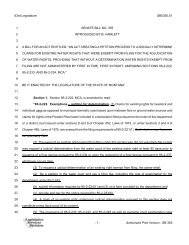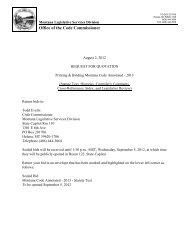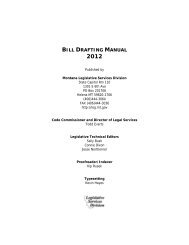Public Comment. Volume III - Montana Legislature
Public Comment. Volume III - Montana Legislature
Public Comment. Volume III - Montana Legislature
Create successful ePaper yourself
Turn your PDF publications into a flip-book with our unique Google optimized e-Paper software.
BROWN LAW F w P.C.<br />
Page 2<br />
April 1 1,2000<br />
simple title.<br />
The vast majority of eminent domain matters are handled through private negotiations.<br />
Most of those are done by land owners who don't even consult their lawyers. Simply put, fee<br />
simple title is normally given up without even considering theconsequences. In litigation many of<br />
condemnation cases are result in a fee simple title taking. The Condemnors file their cases<br />
seeking fee simple title and support their claims with simple proof of their needs to use the land<br />
being taken, as a pipe line for example. At this point the burden shifts to the Condemnee to prove<br />
that there is no need for a fee simple taking and that an easement interest is sufficient. The courts<br />
then make their decisions, under the power conferred under Section 70-30-206, MCA which<br />
allows courts to "limit the interest in real property sought to be appropriated if in the opinion of<br />
the court the interest sought is not necessary." There is nothing in this statute is which creates a<br />
presumption that ~Q<br />
to reasonablv fulfill their needs. There is nothing in this statute which mandates that condemnors,<br />
who privately negotiate takings, do so as easements, unless they get a court order which allows<br />
them to do otherwise.<br />
There are practical reasons why the more limited easement taking should be required<br />
unless a court finds that a fee simple taking is required:<br />
A Easements by their vary nature revert to the owner of the fee when they are<br />
abandoned;<br />
B. Easements through non use are be deemed abandoned;<br />
C. Easement uses are spelled out in the written easement and through rules of<br />
construction are restrictively interpreted against the grantee;<br />
D. Easements don't restrict the fee owner from using the easement area, as long as<br />
such use does not unreasonably burden the use of the grantee;<br />
E. Easements which bifircates a land owner's property by a ribbon of land, create<br />
less of a question as to the land owner's right to cohesively use his property as a<br />
whole; and<br />
F. Easements which separate the land owner's property by a ribbon fiom adjoining<br />
leasehold interests, water sources and fiom points of access, create less questions<br />
at to the land owners continued rights of access.<br />
In each of the considerations A. through F. the burdens through easements are less onerous and<br />
are fraught with less legal questions than fee simple takings.<br />
For all of these reasons, Section 70-30-206, MCA and the related statutes should require<br />
that all takings, should be by easement, unless a court order allowing that fee simple be previously<br />
entered. This would not in any way restrict potential condemnors fiom obtaining what they need<br />
and would in fact place any inconvience caused upon the party who should shoulder it- - the<br />
condemnor.<br />
EQC Eminent Domain Study -61 -



